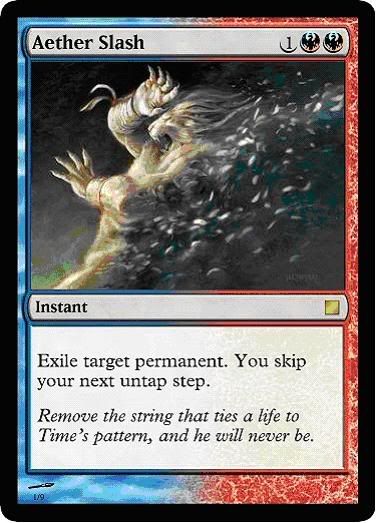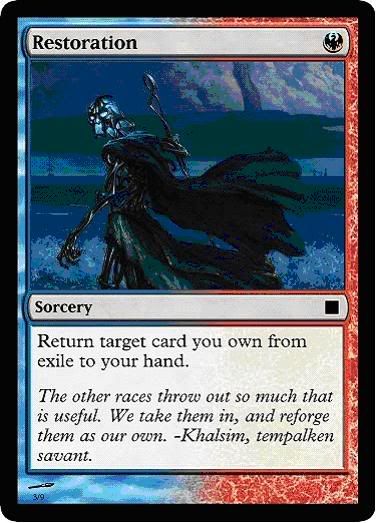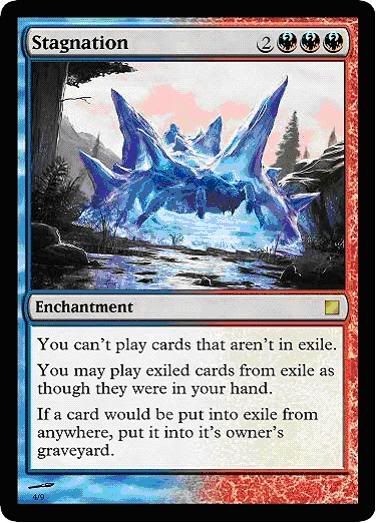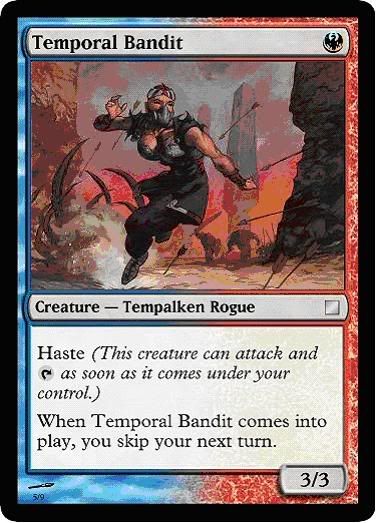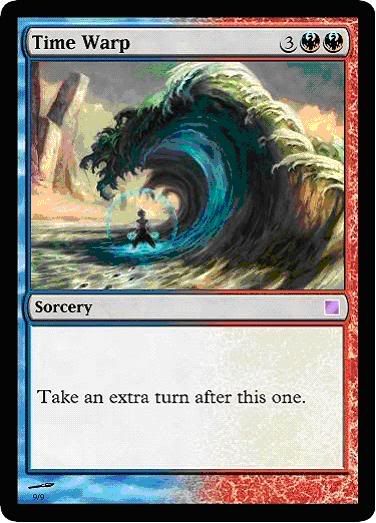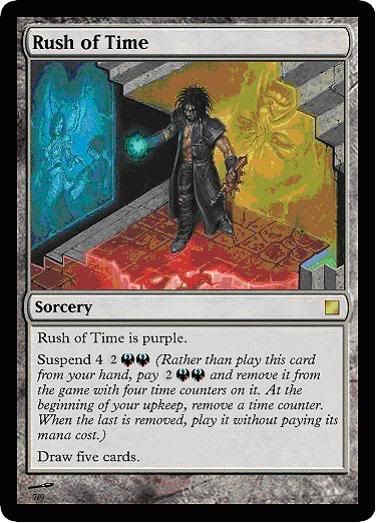This will be the final article in the series. The entire article will be republished into one for linking purposes, and then this series will end.
It's time for the last post of this series: the metagame. I could write a large amount about the metagame, but I'm just going to give you the bare bones. I'll actually be writing a bigger post about the metagame in the next few days that caters to the PTQ players.
The main decks in the metagame are:
Major:
Five-Color Control
Jund
Faeries
Minor:
Jund Mannequin
Elf Combo
Time Sieve Combo
Kithkin
Doran Rock
Merfolk
Man that's a lot of decks. Let's do this:
Five-Color Control
Decklist from USA Nationals, 1st place, by Charles Gindy
Five-Color Control's strength lies in it's ability to play all the best control cards in Standard in one deck. It starts off slow, then uses overwhelming card advantage and card quality to beat you down until it plays Broodmate Dragon, Baneslayer Angel, or Cruel Ultimatum, and then proceeds to win.
How to beat it: Anathemancer is always an excellent choice. If you're not in the colors or need another weapon, Glen Elendra Archmage is a good choice too. Great Sable Stag helps, but won't really win on his own with Lightning Bolt, Firespout and Hallowed Burial providing an answer.
How to play it: Try not to tap out on your opponent's turn unless what you play is far more devastating than anything they can come up with (Broodmate, Baneslayer, Cruel). Use your counterspells only on things you will find hard to deal with if they hit.
Jund
Decklist from Uruguay Nationals, 3rd place, by Rafael Peralta
While I personally disagree with some of his card choices, he's got the invite to Worlds and I don't, so there ya go. The deck focuses on Cascade and powerful aggro creatures to create a rare deck: an aggressive deck with card advantage.
How to beat it: Anathemancer is effective, as is Burrenton Forge-Tender to stop most of their removal. Ethersworn Canonist or Double Negative is good if you're getting beat up by Cascade, and you can outlast them if you're a deck like Five-Color.
How to play it: Play aggressively, but sandbag a Bloodbraid Elf against a control deck. Against Elf Combo or Kithkin, use your sweepers well. Cascade is your friend, and use Lightning Bolt and Maelstrom Pulse aggressively.
Faeries
Decklist from Brazil Nationals, 1st place, by Paulo Vitor Damo de Rosa
Faeries is an aggro-control deck that uses it's creatures to control the board, by countering spells with Spellstutter Sprite, stealing your turn with Mistbind Clique, and disrupting you with Vendilion Clique. Bitterblossom provides incremental card advantage.
How to beat it: Great Sable Stag is the KING against Faeries here. It totally stops them cold, and all they can do is race or play a sideboarded Warren Weirding (very clunky). Against U/B/R Faeries, Anathemancer is good, and Great Sable Stag is still almost as powerful.
How to play it: Save your cards til the right moments: Sprites to counter spells, Scions to counter removal or as combat tricks, Mistbind Clique on their upkeep, etc. Bitterblossom is good to play as early as possible. Don't be afraid to turn aggressive and race.
Elf Combo
Decklist from Russian Nationals, 1st place, by Andrey Kochurov.
Elf Combo uses Heritage Druid, Nettle Sentinel and Elvish Archdruid to get lots of mana, Elvish Visionary and Ranger of Eos to assemble a critical number of Elves, and Regal Force / Mirror Entity as finishers to win the game with.
How to beat it: Lots of sweepers and Wrath effects. Tapping all their creatures with Cryptic Command can also buy you time.
How to play it: Don't be afraid to overextend unless you have a combo + Ranger of Eos. If you don't win fast, you won't win at all. Use your big creatures to win the game.
Jund Mannequin
Decklist from USA Nationals, 4th place, by Brad Nelson.
Jund Mannequin uses a combination of aggressiveness and comes-into-play creatures (reanimated) to win the game. It's an aggro control deck that hinders the opponent while building it's own attacking force.
How to beat it: Removing their graveyard with Jund Charm helps, and it's also vulnerable to Burrenton Forge-Tender and Anathemancer like conventional Jund decks.
How to play it: Feel free to evoke Shriekmaw and Mulldrifter early to bring them back with Makeshift Mannequin. Caldera Hellion is a good controlling card, and your other cards are used for attacking the opponent. Your deck can switch roles between aggro and control repeatedly during a game: use it.
Time Sieve Combo
Decklist from Finland Nationals, 1st place, by Mikko Airaksinen.
This deck focuses on playing artifacts to draw cards and get mana, then use Time Sieve, Time Warp, and Open The Vaults to take infinite turns while drawing lots of cards with Howling Mine. It wins with Tezzeret's ultimate ability.
How to beat it: Counter their Open the Vaults, or be fast enough to kill them first. Maelstrom Pulse on Borderposts is a good idea.
How to play it: Don't be afraid to play Borderposts at full price. Top priority is Howling Mine, then 'draw a card' artifacts, then mana artifacts. Once you hit 5-6 mana, start Time Warping, Sieving, and vault opening until you win.
Kithkin
Decklist from Finland Nationals, 3rd place, by Antti Malin.
Kithkin focuses on playing lots of threats, then pumping them up to win quickly. It's surprisingly resilient, as a Cloudgoat Ranger or Spectral Procession can provide an immediate threat, especially with a pump spell on the battlefield.
How to beat it: Sweepers and Wrath effects, as well as anti-white cards like Stillmoon Cavalier and Deathmark work well. Chaotic Backlash can often deal a lot of damage to them if they don't have Burrenton Forge-Tender.
How to play it: It's an aggro deck: simple to play. Play cards, make them big with Ajani and Honor of the Pure, and bash them to death. Keeping back a Cloudgoat Ranger isn't a bad idea though.
Doran Rock
Decklist from Hungary Nationals, 2nd place, by Gabor Kocsis.
Doran Rock uses powerful creatures and removal to make a very strong midrange deck. It's card quality is difficult to beat.
How to beat it: Anathemancer (do you see now why I play it maindeck?) is good, as is Deathmark and Hallowed Burial, though 2-3 damage sweepers won't cut it against this deck's main threats.
How to play it: Remember: you're a midrange deck. Control their early game, then play your guys turns 4-6 and win before the late game comes online.
Merfolk
Decklist from Switzerland Nationals, 1st place, by Tommi Lindgren.
Merfolk is an aggro-control deck which plays some creatures, and then protects them with counterspells to win. It also features removal and the game-ending Sleep to force through damage and kill opposing creatures.
How to beat it: Sweepers do well, especially the uncounterable Volcanic Fallout. Racing them is often an option, as well: generally you won't face Merfolk often.
How to play it. Treat your creatures as both offensive creatures and blockers. You are an aggro-control deck: you can do both. Go aggressive when you draw Sleep, and go for the kill when necessary. Use your lords well. It's not an easy deck to describe briefly.
And there you have it! You have the sets, the mechanics, what's powerful, what's not, how to draft, what's being played and all the new additions to the game. You're now ready to build a deck and head to FNM without making a complete fool of yourself. But the next step is up to you. Your foot is in the door, but now you have to step through, by playing in events and continuing to learn. When Zendikar comes out, everyone else will be as confused as you are, and you'll be ready to play with the regulars once again.
